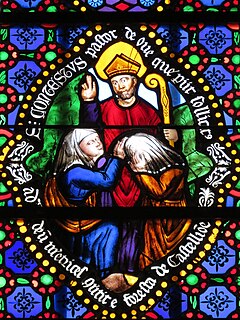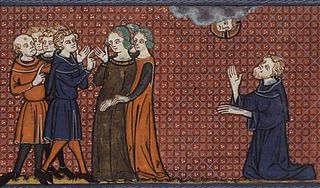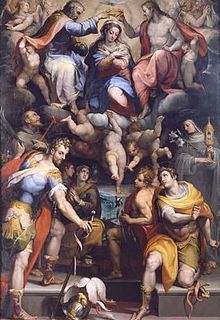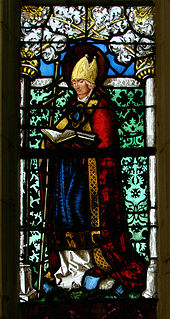
Mark the Evangelist, also known as Saint Mark, is the person who is traditionally ascribed to be the author of the Gospel of Mark. According to Church tradition, Mark founded the episcopal see of Alexandria, which was one of the five most important sees of early Christianity. His feast day is celebrated on April 25, and his symbol is the winged lion.

Pope Clement I was bishop of Rome in the late first century AD. He is listed by Irenaeus and Tertullian as the bishop of Rome, holding office from 88 AD to his death in 99 AD. He is considered to be the first Apostolic Father of the Church, one of the three chief ones together with Polycarp and Ignatius of Antioch.

Pope Fabian was the bishop of Rome from 10 January 236 to his death on 20 January 250, succeeding Anterus. A dove is said to have descended on his head to mark him as the Holy Spirit's unexpected choice to become the next pope. He was succeeded by Cornelius.

Pope Cornelius was the bishop of Rome from 6th or 13th March 251 to his martyrdom in June 253. He was pope during and following a period of persecution of the church, while a schism occurred over how repentant church members who had practiced pagan sacrifices to protect themselves could be readmitted to the church. He agreed with Cyprian of Carthage that those who had lapsed could be restored to communion after varying forms of Reinitiation and Penance. This position was in contrast to the Novatianists, who held that those who failed to maintain their confession of faith under persecution would not be received again into communion with the church. This resulted in a short-lived schism in the Church of Rome that spread as each side sought to gather support. Cornelius held a synod that confirmed his election and excommunicated Novatian, but the controversy regarding lapsed members continued for years.

Saint Afra was martyred during the Diocletian persecution. Along with Saint Ulrich, she is a patron saint of Augsburg. Her feast day is August 7. Afra was dedicated to the service of the goddess, Venus, by her mother, Hilaria. Through his teachings, Bishop Narcissus converted Afra and her family to Christianity. When it was learned that Afra was a Christian, she was brought before Diocletian and ordered to sacrifice to the pagan gods. She refused, and was condemned to death by fire.
Ceraunus (Céran) was the Bishop of Paris. His relics are in the church of St. Genevieve, Paris; they are on the altar of St Clotilda. He is also said to have been bishop 609 to 622.

Contentius was bishop of Bayeux from 480 until his death. He is a Catholic and Orthodox saint. His feast day is 19 January.

March 23 - Eastern Orthodox liturgical calendar - March 25

Dionysius the Great was the 14th Pope and Patriarch of Alexandria from 28 December 248 until his death on 22 March 264. Most information known about him comes from his large surviving correspondence. Only one original letter survives to this day; the remaining letters are excerpted in the works of Eusebius.

Pelagia, distinguished as Pelagia of Antioch, Pelagia the Penitent, and Pelagia the Harlot, was a Christian saint and hermit in the 4th or 5th century. Her feast day was celebrated on 8 October, originally in common with Saints Pelagia the Virgin and Pelagia of Tarsus. Pelagia died as a result of extreme asceticism, which had emaciated her to the point she could no longer be recognized. According to Orthodox tradition, she was buried in her cell. Upon the discovery that the renowned monk had been a woman, the holy fathers tried to keep it a secret, but the gossip spread and her relics drew pilgrims from as far off as Jericho and the Jordan valley.

Saint Victorinus of Pettau was an Early Christian ecclesiastical writer who flourished about 270, and who was martyred during the persecutions of Emperor Diocletian. A Bishop of Poetovio in Pannonia, Victorinus is also known as Victorinus Petavionensis or Poetovionensis. Victorinus composed commentaries on various texts within the Christians' Holy Scriptures.

Nabor and Felix were Christian martyrs thought to have been killed during the Great Persecution under the Roman emperor Diocletian. A tomb in Milan is believed to contain their relics.

Onesiphorus was a Christian referred to in the New Testament letter of Second Timothy. According to the letter sent by St. Paul, Onesiphorus sought out Paul who was imprisoned at the time in Rome.

Nonnus was legendary 4th- or 5th-century Christian saint, said to have been an Egyptian monk who became a bishop in Syria and was responsible for the conversion of St Pelagia the harlot during one of the Synods of Antioch. His feast day is observed on November 10.

Saint Claudius of Besançon, sometimes called Claude the Thaumaturge, was a priest, monk, abbot, and bishop. A native of Franche-Comté, Claudius became a priest at Besançon and later a monk. Georges Goyau in the Catholic Encyclopedia wrote that “The Life of St. Claudius, Abbot of Condat, has been the subject of much controversy.” Anglican Henry Wace has written that "on this saint the inventors of legends have compiled a vast farrago of improbabilities."
Saint Clateus was an early Christian martyr. He was an early Christian bishop in Brescia, Italy and was martyred during the persecutions of Christians by Nero.
Saint Philetus is, along with Saints Lydia, Macedo(n), Theoprepius (Theoprepides), Amphilochius and Cronidas (Cronides), venerated as a Christian martyr. Philetus was supposedly "...a senator who resided in the province of Illyria and was put to death during the persecution under Emperor Hadrian]..."
Confessor of the Faith is a title given by some Christian denominations.

October 22 - Eastern Orthodox liturgical calendar - October 24
Sigrada of Alsace was a Franco-Burgundian countess and mother of Ss. Warin, and Leodegar, and grandmother of St. Leudwinus.